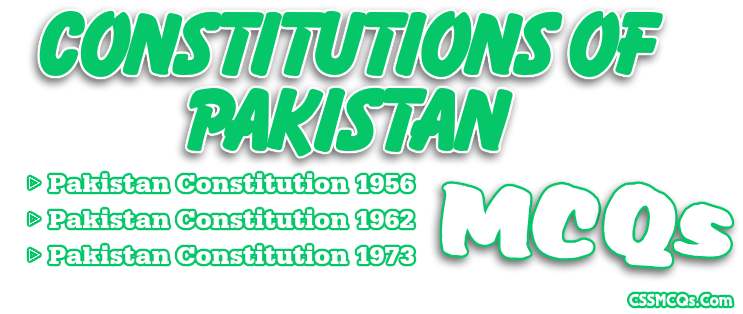Timeline of Constitutional Development of Pakistan
Here, you will have the Timeline of the Constitutional Development of Pakistan from 1947 to the current decade of 2021.
Brief Background Constitutional History:
By the end of World War II, the British imperial government granted independence to its Indian colony and for that matter, the British Parliament enacted the Indian Independence Act, 1947. Under the Act, the British Crown relinquished its sovereign powers over India and transferred those powers to the newly established dominions of India and Pakistan on 14 August 1947. The Government of India Act, 1935, hitherto the constitution of British India, was amended to bring it in consonance with the aims and objectives of independence as laid down in the 1947 Act. The combination of these two constitutional instruments served as an interim constitutional order for both countries until their respective constituent assemblies adopted their own constitutions.
Visit here for MCQs of Constitutions of Pakistan

Timeline of Constitutional Development of Pakistan |
|
| Aug-1947 | The Objective Resolution – the first document of constitutional nature – introduced and adopted by the first Constituent Assembly amid opposition from the Pakistan National Congress, the only opposition party consisting of Hindu minority from East Pakistan. |
| Mar-1949 | The Objective Resolution – the first document of constitutional nature – introduced and adopted by the first Constituent Assembly amid opposition from the Pakistan National Congress, the only opposition party consisting of Hindu minority from East Pakistan. |
| Sep-1950 | Interim Report of the Basic Principle Committee introduced in the Constituent Assembly, but due to public opposition from Bengal and Punjab on the federal formula, debate on the report postponed. |
| Dec-1952 | Basic Principle Committee Report is introduced in the assembly for discussion. |
| Sep-1954 | Report of the Basic Principle Committee is adopted as the draft constitution. |
| Oct-1954 | First Constituent Assembly is dissolved by the Governor-General Ghulam Muhammad. |
| Jun-1954 | Indirect elections held / nominations made to the second Constituent Assembly. |
| Sep-1955 | One-Unit constituted, combining the four provinces and ten princely states of West Pakistan. |
| Feb-1956 | 1956 Constitution promulgated. |
| October 1958 | 1956 Constitution is abrogated and martial law imposed. General Ayub Khan takes over the reins of power. |
| Jun-1962 | General Ayub Khan promulgates the 1962 Constitution through an executive order. |
| Mar-1969 | General Ayub Khan steps down and hands over the reins of power to his successor General Muhammad Yahya Khan who imposes second martial law in the country. |
| Mar-1970 | One-Unit is dismantled and Legal Framework Order is issued to serve as the interim constitution. |
| Dec-1970 | First general elections on adult franchise were held in the country. |
| Dec-1971 | East Pakistan secedes after a brief and bloody civil war, General Yahya Khan steps down and Mr. Zulfiqar Ali Bhutto takes over as the first civilian martial law administrator. |
| Mar-1972 | First Tripartite Accord between the Pakistan Peoples Party and the coalition of National Awami Party and Jamiat-ul-Ulema Pakistan. |
| Apr-1973 | 1973 Constitution adopted. |
| Nov-1985 | Parliament passed the 8th Amendment to 1973 Constitution giving legal and constitutional cover to the suspension of the constitution and all acts of General Ziaul Haq between the suspension and restoration of the constitution. |
| Apr-1997 | The civil government of Nawaz Sharif restored some powers of the Prime Minister under the 1973 constitution which were taken away by 8th Amendment and also took away power of the President to dissolve the National Assembly in his discretion. |
| Oct-1999 | General Musharraf launches the third military coup, suspends the constitution, dismisses the federal and provincial governments, assumes the office the Chief Executive, declares state of emergency and promulgates the Provincial Constitutional Order, 1999. |
| Jun-2001 | Musharraf assumes the office of the President of Pakistan. |
| Aug-2002 | Musharraf issued the Legal Framework Order, 2002, providing for the general elections of 2001, restoration of the 1973 constitution with numerous amendments. |
| Dec-2003 | Parliament passed the 17th Amendment in the 1973 constitution, incorporating the Legal Framework Order, 2002 into the constitution, reversing the 13th Amendment by bringing the Prime Minister and National Assembly, once again, under the thumb of the President, which office was occupied by General Musharraf. |
| Nov-2007 | Musharraf issued another Legal Framework Order No.1 of 2007, assuming to himself the power of amending the constitution, and suspending the fundamental rights. He steps down as the military chief and is sworn as the President for the third term. |
| Feb-2008 | General elections held in the country, in which General Musharraf’s supported party was defeated. |
| Aug-2008 | Musharraf resigns from the office of President under intense pressure and ahead of impeachment charges. |
| Apr-2010 | 18th Amendment, removing discretionary powers of the President to dissolve the national assembly and restoring to the office of Prime Minister all powers under the constitution that were taken by the military dictators General Ziaul Haq and Mussharaf, and turning Pakistan from a semi-presidential to parliamentary system. |

